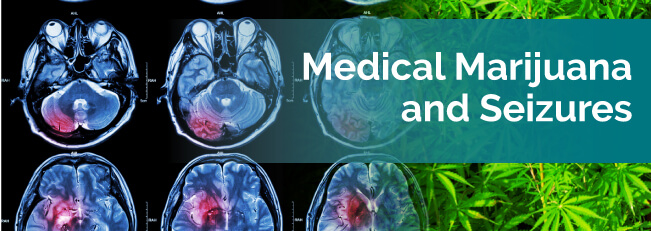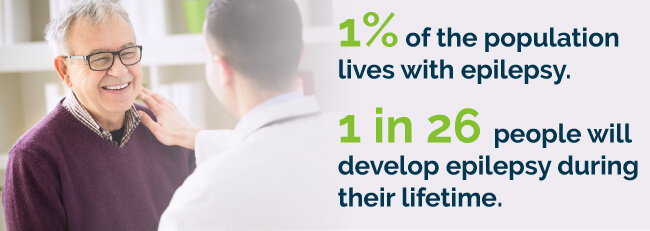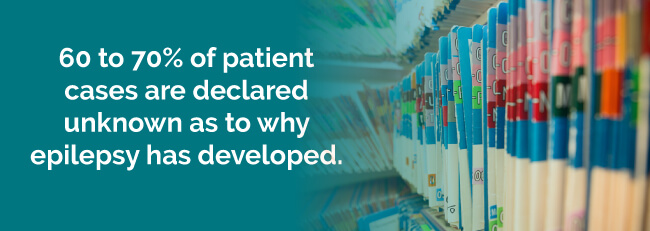
Medical providers are more likely to recommend a cannabis treatment plan to patients with seizures as the medical community continues to discover the therapeutic properties of this substance. Since epilepsy and seizures can provoke a myriad of unwanted side effects that interfere with a person’s wellbeing, it’s crucial to explore alternative medication options that can bring patients relief. Today, cannabis has become a preferred treatment option that helps promote a sense of enhanced wellbeing while reducing the impact of seizures.
According to the Epilepsy Foundation, epilepsy and seizures affect almost 3 million Americans of all ages, at an estimated annual cost of $15.5 billion in direct and indirect costs. A cure does not exist for seizures or epilepsy, but certain medications can prevent epileptic seizures if taken regularly.
Available prescription treatments, however, feature numerous side effects as well as increased health risks for women and older patients. In some cases, the treatments may also be ineffective. Using medical marijuana for seizures has become a growing area of interest for pharmaceutical groups, which have begun clinical trials on medical cannabis for seizure treatment.
Medical marijuana for epilepsy and seizures has also gained support from the Epilepsy Foundation — as well as acknowledgments from organizations like the American Epilepsy Society — as a potential treatment, following the appropriate research and testing trials.
Understanding seizures, as well as their available treatments, is the first step towards understanding why medical cannabis for seizures is a viable treatment option that offers little to no side effects, giving patients relief and safety from seizures while letting them enjoy their daily life.
Many patients suffering from epilepsy and other seizure disorders have found great relief from medical marijuana, either taken by itself or in conjunction with more traditional medications. Others who suffer from seizures but can’t tolerate anti-seizure medications have used medical marijuana to successfully control their seizures.
Medical marijuana lacks the side effects found in traditional medicines used to treat epilepsy. Marijuana side effects are typically mild and are classified as “low-risk.” Recent open-label and gold-standard studies have provided concrete evidence of medical marijuana’s side effects when used with and without anti-seizure medicine.
Side effects in these studies included:
It’s important to note that medical cannabis and the patient’s current anti-seizure medicine can interact, thereby causing certain side effects. Participants in the study also described medical marijuana’s effects, which went away, as mild or moderate.
Seizures in the study decreased by 54 percent for participants in the open-label study, who ranged from 2 to 26 years of age and didn’t respond previously to traditional anti-seizure medicine. Researchers also found that 89 percent of children participants’ seizures were reduced using medical cannabis.

In the two gold-standard studies, seizures dropped by more than 40 percent, while patients who received the placebo reported a seizure decrease of less than 20 percent. The overall response from the study was that seven out of every eight participants improved with medical marijuana for their seizures.
Another study, which focused on children with epilepsy, found medical cannabis reduced the frequency of seizures by 47 percent, which improved further to 50 percent after 20 weeks of treatment. Nine percent of patients also became seizure-free by using medical marijuana for their seizures.

An earlier medical marijuana study for seizures, completed in Israel, found similar results. An even earlier study from 2003, by researchers at Virginia Commonwealth University, found that the ingredients in marijuana and the cannabinoid receptor protein produced naturally in the body played a critical role in controlling spontaneous seizures in epilepsy.
The results from these various studies are promising and provide the insight researchers, parents and those with epilepsy are looking for when they ask if medical marijuana for seizures is a viable option. The lack of research into medical marijuana previously made this question difficult to answer using concrete scientific data.
Now that governments are beginning to accept marijuana as a medicine, studies are starting in earnest to learn about using medical cannabis for seizures as well as developing treatment plans and finding the best strain of medical marijuana for treating seizures.
Medical marijuana is highly esteemed by medical professionals for its ability to target multiple symptoms in patients while stimulating little to no adverse reactions in the process. For patients experiencing seizures, cannabis is a viable treatment option that targets and controls their unwanted symptoms.
Although the side effects of seizures are likely to vary from patient to patient, many individuals are likely to experience relief from the following symptoms when enrolling in a medical marijuana treatment plan:
Cannabis has anti-inflammatory or pain reduction properties that can help a patient during the recovery process after a seizure. Medical marijuana can help boost serotonin levels which foster better emotional health, too.
If you’re interested in enrolling in a medical marijuana plan for seizures, it’s vital to connect with a certified marijuana-informed doctor in your state. Every state has its own laws governing medical marijuana use. To explore the possibility of receiving medicinal cannabis prescriptions, schedule an appointment with your primary doctor.
If medical marijuana is permitted in your state, your physician will evaluate your symptoms to determine whether you’d benefit from a medical marijuana plan. Many states require you to enroll as a certified patient, which includes paying an enrollment fee and receiving a medical marijuana I.D. card that will grant you access to your necessary medications.
Unlike other prescription drugs that often require one form of intake, there are multiple ways to approach your cannabis treatment plan.
Patients who take medical marijuana for seizures often find it beneficial to consume their medications in the following ways:
Since seizures often provoke sudden symptoms, smoking and vaporizing are an ideal way to promote immediate relief. Inhaled methods allow the effects of cannabis to kick in faster, which helps users manage their symptoms when a seizure occurs.
The state laws for medical marijuana differ for each state, so your ability to access certain cannabis varieties or intake methods may vary.
One of the biggest movements to producing medical cannabis for seizure use is by GW Pharmaceuticals, a British pharmaceutical company, which conducted the earlier open-label study on the effects of medical marijuana on seizures. The product they tested is called Epidiolex, a 99 percent, oil-based extract of cannabidiol (CBD) that’s purified.
More than 85 types of cannabinoids are available, and CBD is one of the most popular ones. It’s known for its therapeutic relief of discomfort as well as eliminating or reducing seizures for some patients. CBD works by binding to receptors throughout the body. The second-most-popular type of cannabinoid is tetrahydrocannabinol (THC), which binds to the brain’s receptors, causing a psychoactive response.
A selection of cannabinoids, CBD included, effectively target epileptic seizures. By discovering and isolating these cannabinoids, growers have been able to provide families and patients with marijuana strains for their epilepsy. The cannabinoids that target epilepsy and seizures include:
Growers across the U.S. offer more than 80 marijuana strains for treating seizures. One of the most well-known strains is called Charlotte’s Web. Created for Charlotte Figi, the strain was developed by Realm of Caring, a medical marijuana group, and grown by the Stanley Brothers.
By using medical marijuana for her seizures, Charlotte’s seizures went from 1,200 a month to only one to two episodes. Medical studies of Charlotte’s Web demonstrate the strain’s effectiveness. A 2016 study in Colorado found 10 percent of patients became seizure-free while 60 percent reduced their epileptic episodes by 50 percent with Charlotte’s Web.
Other available marijuana strains that treat seizures and epilepsy include:
Strains like GI001 offer low amounts of THC, while the Bedford Glue strain contains a THC over 20 percent, but without debilitating effects. Athabasca also contains enough THC to create a mild psychoactive effect that’s helped some patients with epilepsy.
One of the challenges in using medical marijuana for seizures is the fact that a disease like epilepsy isn’t a one-
size-fits-all disorder. It features three categories of seizures, which are then sub-divided into additional types of seizures. Treating seizures, even with prescription medicine, requires trying different prescriptions and dosages.
While pharmaceutical companies have had the opportunity to test and develop multiple drugs for treating seizures, medical marijuana has been limited in taking advantage of those opportunities, due to federal and state regulations in the U.S., which have only recently been lifted in 29 states across the country.
The increased nationwide support for legal medical cannabis is helping marijuana be seen more widely as a medicine and is spurring the development of strains that treat diseases like epilepsy, which require a broader selection of individualized strains to help every patient gain normalcy back into their life.
Before you start a medical marijuana plan to treat your seizures, it’s important to understand the various types of seizures experienced by patients and the best treatment options for these symptoms. The more you know about your condition, the more likely you are to have more success when deciding what best works for you.
A seizure is caused by an abnormal overactivation of neurons in a specific part of the brain. If it happens in the motor area of the brain, then the other side of the body can start jerking involuntarily. Or if it happens in the visual part of the brain, then that person may see colorful flashing lights in their visual space. In many cases the seizure stops there. But in some cases, the abnormal neuronal activity can spread to the other side of the brain, causing jerking movements of both sides of the body and loss of consciousness. Learn more below about how medical marijuana can help treat seizures.
Seizures are classified as either nonepileptic or epileptic. When a seizure occurs two or more times — unprovoked by other health issues like blood clots, and spaced more than 24 hours apart — it’s often diagnosed as epilepsy.
Epilepsy is a disease. In the U.S., one percent of the population lives with epilepsy, and it’s estimated that one in 26 people will develop epilepsy during their lifetime, with children and older adults being most likely to develop the disease.

Seizures are classified into three areas — generalized onset, focal onset and unknown onset. All three categories cause electrical impulses in the brain that result in the physical symptoms of a seizure, as discussed below. To break the classification of seizures down further, generalized onset and focal onset seizures each have their own types of seizures.
The six types of generalized onset seizures include:
The three types of focal onset seizures include:
Focal onset aware seizures affect 14 percent of people with epilepsy and are divided into four subcategories by symptoms — motor, autonomic, sensory and psychological. These subcategories are distinguished by their symptoms.
Motor symptoms, for example, cause the body to jerk and stiffen, while sensory symptoms cause odd or unusual sensations relating to the senses, such as strange sounds or weird tastes.
Autonomic symptoms relate to what functions your body automates, such as your bladder and intestines, and can cause you to lose control of your bladder during a seizure. Psychological symptoms involve intense emotions of fear or pleasure as well as deja-vu.
Focal onset impaired seizures affect 36 percent of those with epilepsy. During these seizures, you lose awareness and your body does a series of repetitive and coordinated movements, like smacking your lips, chewing or even walking.
Partial seizures begin as either simple or complex before they transition into a violent Grand-Mal seizure. They’re also, in some cases, treatable through surgery.
Unknown onset seizures are seizures not witnessed or seen by other parties — who are essential to helping identifying seizures — as patients can lose consciousness. Seizures are also called “unknown onset seizures” when the beginning of the seizure isn’t known.
Because of the violent nature of some of these seizures — 34 percent of sudden deaths in children result from epilepsy — it’s essential that patients have access to medication that treats their symptoms and prevents or reduces future seizures.
The reason why patients develop epilepsy often goes unanswered, with 60 to 70 percent of patient cases declared unknown. If a cause is determined, it’s often a brain tumor, brain infection, head trauma or stroke. Genetics can also contribute to the development of epilepsy.

Epilepsy is categorized into a multitude of syndromes, based on factors ranging from the part of the brain being affected and the severity of the seizures to the cause and type of seizures the patient is experiencing. One of the rarest syndromes, yet one that has contributed substantially to the use of medical marijuana for epilepsy, is Dravet Syndrome.
Dravet Syndrome affects one in almost 16,000 infants. It begins within the first year and causes prolonged and frequent seizures which often lead to accidents, injuries and death. Traditional prescription medicines are available to treat Dravet Syndrome but aren’t always effective.
The family of Charlotte Figi encountered this challenge when their daughter continued to suffer from 300 seizures every week, even with prescription treatments. That’s why they turned to medical marijuana for their daughter’s seizure symptoms.
Seizures have a wide variety of possible symptoms, depending on what parts of the brain are involved. Many types of seizures cause loss of awareness, twitching or shaking of the body. Symptoms of seizures come on suddenly, over just seconds to a minute, and commonly include:
When patients begin treatment for seizures or epilepsy, only 60 percent of them find a medicine that controls their seizures within the first two prescriptions used. When doctors try more than two drugs, the chance of the medicine working decreases substantially.
This is why, according to the Epilepsy Foundation, prescription medications control seizures in only about 70 percent of patients — which leaves 30 percent of patients without relief.
More than 31 generic drugs for epilepsy are available, with several offered under different brand names, such as Lyrica, Topamax and Epanutin. Like many prescription drugs, each comes with a series of potential side effects, some of which pose a serious health risk.
Traditional epileptic medications come with a catalog of side effects such as:
Serious health risks from these medicines include:
Some of these drugs, such as Clobazam and Clonazepam, also tend to become ineffective over time, as your body builds a tolerance for the medicine. In these scenarios, you’re faced with either changing your prescription or increasing your dosage, which could potentially lead to an adverse reaction.
Anti-seizure medicine also increases the risk of bone loss, especially in women who are already at an increased risk for osteoporosis. Patients who regularly use anti-seizure medicine have a 29 percent increase in hip fractures over a five-year period. The reason is that the drugs interfere with the body’s absorption of critical vitamins like calcium and Vitamin D.
Women face additional challenges when using epileptic medicine, as well. Oral contraceptives and hormonal implants, for example, are less effective on anti-seizure medicine. Other forms of birth control, such as intrauterine devices (IUDs), are unaffected by epileptic drugs.
Pregnancy while on seizure medications also provides increased risks. Birth defects increase by 6.1 percent with epileptic medications, which is 3.9 percent higher than the average rate of congenital disabilities. Even without taking medicine, pregnancies for women with epilepsy are still at a higher risk for congenital disabilities.
One of the ways doctors try to combat these side effects and risks is through natural remedies, like encouraging patients to modify their lifestyle to reduce seizure triggers. Stress, lack of sleep and even a change in hormones can all trigger a seizure.
Self-management tactics include:
Due to the side effects of prescription drugs for seizures, as well as their ineffectiveness for some patients, the medical community has continued to search for ways to manage or control seizure symptoms. While natural self-management approaches help, they aren’t a complete remedy.
Looking for natural remedies, however, has led doctors and patients like Charlotte Figi’s family to discover the use and impact of medical marijuana on seizures.
Most medical marijuana states allow the use of medical marijuana for epilepsy and/or seizures. If you or a loved one is looking to find relief from any type of seizure disorder, MarijuanaDoctors.com can help. We can connect you with hundreds of quality marijuana doctors across the country in all legal marijuana states and ensure you’re in compliance with your state laws. Search for a doctor or dispensary today and to help improve your quality of life!
Find A Doctor Find A Dispensary